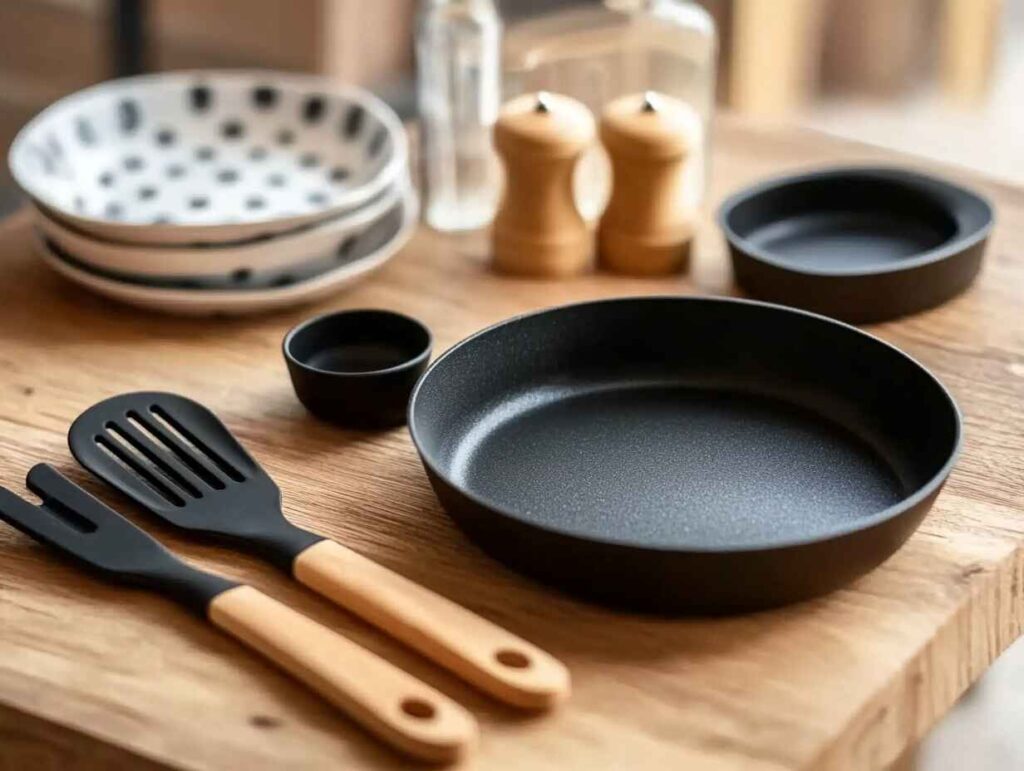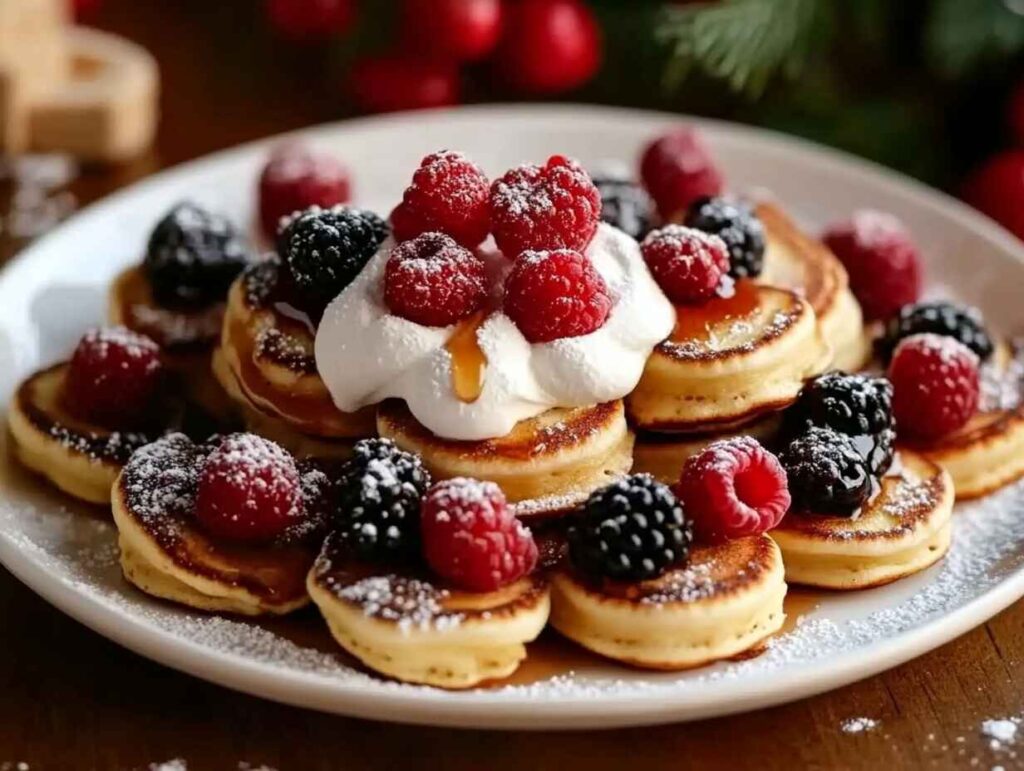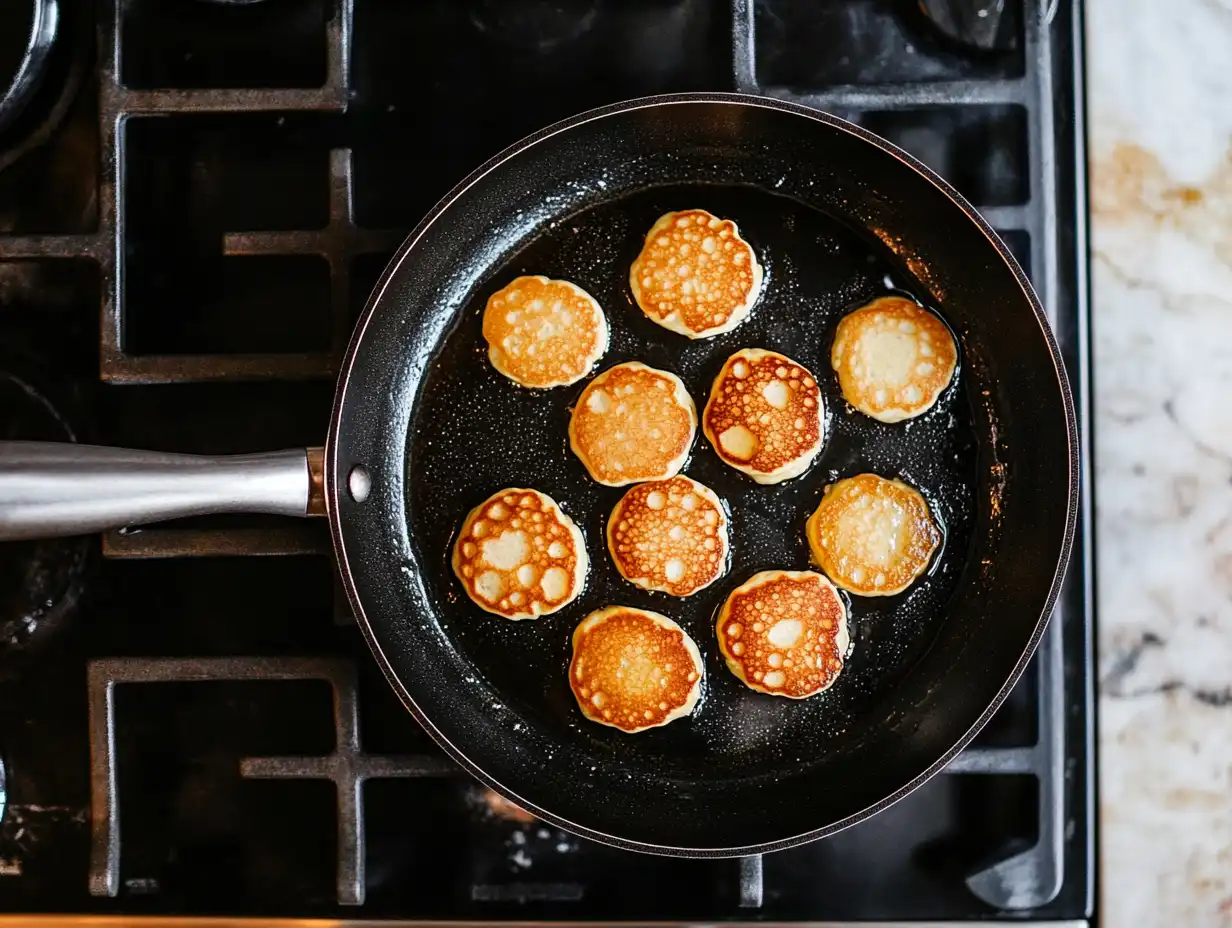How long do you cook mini pancakes for ? Mini pancakes, also known as silver dollar pancakes, are bite-sized versions of the classic breakfast favorite. Their petite size makes them a perfect choice for kids, brunches, or even as a fun snack. However, cooking them to perfection requires some finesse, as their small size means they can overcook or undercook quickly.
So, how long should you cook mini pancakes to get that golden, fluffy texture? The answer depends on several factors like cooking method, batter consistency, and heat setting. In this article, we’ll break down everything you need to know to cook mini pancakes just right, ensuring they’re perfectly browned on the outside and soft on the inside.
Table of Contents
The Perfect Cooking Time for Mini Pancakes
What Factors Influence Cooking Time?
Cooking time for mini pancakes can vary based on:
- Heat Setting: Low-to-medium heat is ideal for even cooking without burning.
- Batter Thickness: A thick batter takes longer to cook through, while a thinner batter cooks faster.
- Cooking Surface: Non-stick pans, griddles, and ovens each have unique heat distribution characteristics.
- Size of Pancakes: The smaller the pancakes, the quicker they cook. Mini pancakes usually measure about 2-3 inches in diameter.
Ideal Cooking Time on a Stovetop
The stovetop is the most common method for cooking mini pancakes. On medium heat:
- Cook the first side for 1-2 minutes, or until you see bubbles forming and the edges looking slightly dry.
- Flip the pancakes and cook the second side for 30-60 seconds, or until it turns golden brown.
For consistent results, preheat your pan for a few minutes before adding the batter. Ensure the heat isn’t too high to avoid burning the exterior while the inside remains undercooked.
Baking Mini Pancakes in the Oven
While unconventional, the oven is a great method for batch-cooking mini pancakes:
- Preheat the oven to 375°F (190°C).
- Pour batter into a greased mini muffin tin or onto a baking sheet lined with parchment paper.
- Bake for 8-10 minutes, checking for doneness by inserting a toothpick into the center. If it comes out clean, they’re ready.
This method ensures even cooking but doesn’t give you the classic pan-fried texture.
Tips for Getting the Best Mini Pancakes
How to Achieve Even Cooking
One of the keys to perfect mini pancakes is ensuring they cook evenly. Here are a few tips to help you avoid unevenly cooked pancakes:
- Preheat Your Pan or Griddle: This is crucial! Always preheat your cooking surface before adding the batter. A properly heated surface ensures that the pancakes cook evenly from the moment the batter hits the pan.
- Use a Ladle or Spoon: To make your mini pancakes uniform in size, use a ladle or spoon to measure out the batter. This consistency in size helps them cook at the same rate.
- Avoid Crowding the Pan: If you’re cooking several pancakes at once, don’t overcrowd the pan. Leave some space between them to allow for even heat distribution. Crowding can cause pancakes to stick together and cook unevenly.
Signs That Mini Pancakes Are Done
Knowing when your mini pancakes are done is essential to avoid overcooking or undercooking them:
- Bubbles on the Surface: When the pancakes start to form bubbles on the surface and the edges look set (not shiny), it’s time to flip them.
- Golden Brown: After flipping, the pancakes should be golden brown on both sides. This is an indication that they’re cooked through and have a crispy, yet soft texture.
- Toothpick Test: If you’re unsure, you can use a toothpick to poke the center of the pancake. If it comes out clean, your mini pancake is ready.
How to Keep Mini Pancakes Warm
If you’re cooking in batches and want to keep your pancakes warm, place them on a baking sheet in a 200°F (90°C) oven. This will prevent them from getting cold while you finish cooking the rest.
Tools You Need to Cook Mini Pancakes

Best Non-Stick Pans for Mini Pancakes
When it comes to cooking mini pancakes, using the right pan makes all the difference. A non-stick skillet or griddle is ideal because it prevents the pancakes from sticking, ensuring easy flipping and cleanup. Here are some of the best pans for the job:
- Cast Iron Skillet: A cast-iron skillet offers excellent heat distribution and retention. Although it requires seasoning, it’s perfect for achieving golden, crispy edges on your pancakes.
- Ceramic Non-Stick Pan: Ceramic-coated pans are another great option. They are free from harmful chemicals like PTFE and PFOA, making them safer for cooking at higher temperatures.
- Electric Griddle: An electric griddle provides an even cooking surface with adjustable temperature controls, making it ideal for cooking large batches of mini pancakes at once.
Whichever pan you choose, make sure it has a flat surface and a good layer of non-stick coating. This will help ensure that your pancakes cook evenly and don’t stick.
Other Helpful Equipment
While the pan is the most essential tool, here are a few other gadgets that can make the cooking process easier:
- Ladle or Measuring Cup: To ensure that each mini pancake is the same size, use a ladle or a 1/4-cup measuring cup to pour the batter onto the pan. This also helps control portion sizes.
- Spatula: A thin, flexible spatula is necessary for flipping your mini pancakes without tearing them. Opt for a silicone or wooden spatula to avoid damaging your non-stick cookware.
- Baking Tray or Muffin Tin (for Oven Cooking): If you’re using the oven to bake mini pancakes, a mini muffin tin or a rimmed baking sheet will help shape and organize your pancakes. Both options ensure uniform cooking and easy handling.
Different Cooking Methods Explained
Stovetop Cooking: Step-by-Step Guide
Cooking mini pancakes on the stovetop is the most traditional and widely used method. Here’s a step-by-step guide to ensure perfect results every time:
- Preheat the Pan: Set your stovetop to medium heat and let your non-stick skillet or griddle preheat for 2-3 minutes. Add a small amount of butter or oil and spread it evenly to prevent sticking.
- Pour the Batter: Use a ladle or small spoon to drop about 2 tablespoons of batter onto the skillet for each pancake. Space them apart to avoid sticking together.
- Cook the First Side: Allow the pancakes to cook for 1-2 minutes or until bubbles form on the surface, and the edges start to look dry. Adjust the heat if the bottoms are browning too quickly.
- Flip the Pancakes: Gently slide a spatula under each pancake and flip it over. Cook for another 30-60 seconds until the other side turns golden brown.
- Serve Hot: Remove the pancakes from the skillet and serve immediately, or place them on a baking sheet in a warm oven to keep them hot.
Using a Pancake Maker or Electric Griddle
For those who want a hassle-free experience or need to cook a large batch, pancake makers or electric griddles are fantastic options.
- Set Up the Griddle: Plug in the electric griddle and preheat it to 350°F (175°C), or as per the manufacturer’s instructions.
- Prepare the Surface: Apply a thin layer of butter or cooking spray to prevent sticking.
- Cook the Pancakes: Pour batter directly onto the griddle, spacing each pancake evenly. Follow the same timing rules: cook for 1-2 minutes on the first side and 30-60 seconds on the second.
- Consistent Results: Griddles distribute heat evenly, making it easier to achieve uniformly cooked pancakes.
Can You Use an Air Fryer?
Yes! Cooking mini pancakes in an air fryer is a unique but effective method that creates fluffy, slightly crispy pancakes.
- Preheat the Air Fryer: Set your air fryer to 325°F (160°C).
- Prepare the Batter: Pour your pancake batter into small silicone molds or onto parchment paper cut to fit the air fryer basket.
- Cook in Batches: Cook for 5-7 minutes, checking halfway to ensure even cooking.
- Serve and Enjoy: Once golden brown, remove the pancakes from the air fryer and serve with your favorite toppings.
This method is particularly useful for those who want to avoid stovetop cooking or prefer a hands-off approach.
Common Mistakes and How to Avoid Them
Overcooking or Undercooking Mini Pancakes
One of the most frequent issues when making mini pancakes is cooking them too much or not enough. Here’s how to avoid these pitfalls:
- Overcooking: This often happens when the heat is too high. The outsides cook too quickly, turning dark brown or even burnt, while the inside remains raw.
- Solution: Keep the heat on medium or medium-low. This allows the pancakes to cook evenly inside and out without burning the surface.
- Undercooking: If you remove the pancakes from the pan too soon, they may look golden on the outside but remain gooey in the middle.
- Solution: Always wait for bubbles to appear on the surface before flipping, and cook the second side until golden brown. A toothpick test can confirm the center is fully cooked.
Using the Wrong Heat Setting
The temperature of your pan or griddle plays a crucial role in the success of your mini pancakes:
- Too High: Results in burnt pancakes with raw centers.
- Too Low: Leads to uneven cooking and pale, underwhelming pancakes.
- Optimal Heat: Use medium heat for stovetops and 350°F (175°C) for electric griddles.
Always preheat your pan for a few minutes to ensure consistent cooking from the first pancake to the last.
Using Too Much or Too Little Oil
The amount of oil or butter you use can affect the texture and appearance of your mini pancakes:
- Too Much Oil: Creates a greasy pancake and may cause uneven browning.
- Too Little Oil: Increases the risk of sticking, even on non-stick surfaces.
- Solution: Use a small amount of butter or oil just enough to lightly coat the pan. A silicone brush or paper towel can help distribute it evenly.
Not Measuring Ingredients Accurately
Mini pancakes rely on the right consistency of batter for their fluffy texture. Eyeballing measurements can result in batter that is too thick or too runny:
- Solution: Use measuring cups and spoons for precise results. The batter should be thick enough to hold its shape when poured but still pourable.
Skipping the Flip Timing
Flipping pancakes too early or too late can ruin their texture and appearance:
- Too Early: Leads to messy, undercooked pancakes.
- Too Late: Results in uneven shapes and overcooked bottoms.
- Solution: Wait for bubbles to form and edges to look dry before flipping. Practice patience it pays off!
FAQs
How Thick Should Mini Pancake Batter Be?
The consistency of mini pancake batter is crucial for achieving the perfect texture. The batter should be:
- Thick Enough to Hold Shape: When poured onto a pan, the batter should spread slightly but not run all over the surface.
- Slightly Thinner than Regular Pancake Batter: Mini pancakes cook faster, so a slightly thinner batter ensures even cooking.
- Tip: If your batter feels too thick, add a tablespoon of milk at a time to reach the right consistency. If it’s too thin, mix in a small amount of flour.
What Temperature is Best for Cooking Mini Pancakes?
Temperature control is critical to avoid burning or undercooking mini pancakes.
- For Stovetop Cooking: Use medium heat. A good test is to sprinkle a few drops of water on the pan—if they sizzle and evaporate quickly, it’s ready.
- For Electric Griddles: Set the temperature to 350°F (175°C) for consistent results.
- Tip: Always preheat your cooking surface for 2-3 minutes before starting to cook.
Can Mini Pancakes Be Made Ahead of Time?
Yes, mini pancakes are perfect for making ahead and reheating:
- Make Ahead: Cook your pancakes as usual, then let them cool completely. Store in an airtight container in the refrigerator for up to 3 days or freeze them for up to 3 months.
- Reheating Options:
- Microwave for 10-15 seconds per pancake.
- Warm in a toaster oven or regular oven at 300°F (150°C) for 5-7 minutes.
- Use a skillet on low heat to reheat without losing crispness.
What Are the Best Toppings for Mini Pancakes?
Mini pancakes are incredibly versatile and can be customized with a variety of toppings:

- Sweet Options: Maple syrup, whipped cream, fresh fruit, powdered sugar, or chocolate chips.
- Savory Options: Cream cheese, scrambled eggs, or smoked salmon for a unique twist.
- Tip: Create a pancake bar with different toppings for a fun brunch idea.
Can I Use a Store-Bought Pancake Mix?
Absolutely! Store-bought pancake mix is a time-saving option and works well for mini pancakes. To enhance the flavor:
- Add vanilla extract or a pinch of cinnamon.
- Replace water with milk or buttermilk for a richer taste.
- Fold in mix-ins like chocolate chips, blueberries, or shredded coconut.
How Do I Keep Mini Pancakes From Sticking?
Even with a non-stick pan, pancakes can stick if proper precautions aren’t taken:
- Use Oil or Butter: A small amount of butter or cooking spray is enough to prevent sticking.
- Preheat the Pan: Ensure the pan is hot before pouring the batter.
- Avoid Overcrowding: Too many pancakes at once can lower the pan’s temperature and increase sticking.
Conclusion
Mastering mini pancakes is all about precision and timing. Whether you choose the stovetop, oven, or air fryer method, the key is consistent heat and attentive flipping. With the techniques shared here and additional resources like Mini Pancakes Recipes and Serving Ideas, you’re well on your way to creating perfectly fluffy and golden mini pancakes every time! Typically, mini pancakes take about 1-2 minutes per side on a stovetop and around 8-10 minutes in an oven. Keeping the batter at the right consistency and using the correct tools ensures that your pancakes are golden brown on the outside and fluffy on the inside.
With the tips, tools, and methods shared in this guide, you’re now equipped to whip up a batch of mini pancakes that will delight your family and friends. Add your favorite toppings, experiment with flavors, and enjoy this bite-sized breakfast treat any time of day!
For more on mini pancakes and related breakfast delights, explore these articles:
- Mini Pancakes Recipes and Serving Ideas: Dive into creative recipes and fun serving suggestions for mini pancakes.
- What Is Another Name for Mini Pancakes?: Learn about the various names and regional variations of mini pancakes.
- What Are Mini Pancakes Made Of?: Discover the ingredients and preparation techniques for making mini pancakes from scratch.
- How Do You Keep Mini Pancakes Warm for a Party?: Essential tips for serving mini pancakes at gatherings.

